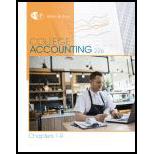
RATIO ANALYSIS OF COMPARATIVE FINANCIAL STATEMENTS Refer to the financial statements in Problem 24-8B.
REQUIRED
Calculate the following ratios and amounts for 20-1 and 20-2 (round all calculations to two decimal places).
- (a) Return on assets (Total assets on January 1, 20-1, were $111,325.)
- (b) Return on common stockholders’ equity (Total common stockholders’ equity on January 1,20-1, was $82,008.)
- (c) Earnings per share of common stock (The average numbers of shares outstanding were 6,300 shares in 20-1 and 6,900 in 20-2.)
- (d) Book value per share of common stock
- (e) Quick ratio
- (f)
Current ratio - (g)
Working capital - (h) Receivables turnover (Net receivables on January 1, 20-1, were $28,995.)
- (i) Merchandise inventory turnover (Merchandise inventory on January 1, 20-1, was $32,425.)
- (j) Debt-to-equity ratio
- (k) Asset turnover (Assets on January 1,20-1, were $111,325.)
- (l) Times interest earned ratio
- (m) Profit margin ratio
- (n) Assets-to-equity ratio
- (o) Price-earnings ratio (The market price of the common stock was $120.00 and $110.00 on December 31, 20-2 and 20-1, respectively.)
Calculate the following ratios and amounts for 20-1 and 20-2.
- (a) Return on assets
- (b) Return on common stockholders’ equity
- (c) Earnings per share
- (d) Book value per share
- (e) Quick ratio
- (f) Current ratio
- (g) Working capital
- (h) Receivables turnover and average collection period
- (i) Merchandise inventory and average number of days to sell inventory
- (j) Debt-equity ratio
- (k) Assets turnover
- (l) Times interest earned ratio
- (m) Profit margin ratio
- (n) Assets to equity ratio
- (o) Price-earnings ratio
Explanation of Solution
Financial statement analysis:
Financial statement analysis is a valuable measure for evaluating management performance.
The methods of analysis must be used carefully with in their limitations.
(a)
Calculate return on assets during the period of 20-2.
Calculate return on assets during the period of 20-1.
(b)
Calculate return on common stockholders’ equity during the period of 20-2.
Calculate return on common stockholders’ equity during the period of 20-1.
(c)
Calculate earnings per share of common stock during the period of 20-2.
Calculate earnings per share of common stock during the period of 20-1.
(d)
Calculate book value per share of common stock during the period of 20-2.
Calculate book value per share of common stock during the period of 20-1.
(e)
Calculate quick ratio during the period of 20-2.
Calculate quick ratio during the period of 20-1.
(f)
Calculate current ratio during the period of 20-2.
Calculate current ratio during the period of 20-1.
(g)
Calculate working capital during the period of 20-2.
Calculate working capital during the period of 20-1.
(h)
Calculate receivables turnover during the period of 20-2.
Calculate receivables turnover during the period of 20-1.
Calculate average collection period during the period 20-2.
Calculate average collection period during the period 20-1.
(i)
Calculate merchandise inventory turnover during the period 20-2.
Calculate merchandise inventory turnover during the period 20-1.
Calculate average number of days to sell inventory during the period of 20-2.
Calculate average number of days to sell inventory during the period of 20-1.
(j)
Calculate debt-equity ratio during the period of 20-2.
Calculate debt-equity ratio during the period of 20-1.
Calculate asset turnover ratio during the period of 20-2.
Calculate asset turnover ratio during the period of 20-1.
(l)
Calculate time interest earned ratio during the period of 20-2.
Calculate time interest earned ratio during the period of 20-1.
(m)
Calculate profit margin ratio during the period of 20-2.
Calculate profit margin ratio during the period of 20-1.
(n)
Calculate assets to equity ratio during the period of 20-2.
Calculate assets to equity ratio during the period of 20-1.
(o)
Calculate price earnings ratio during the period of 20-2.
Calculate price earnings ratio during the period of 20-2.
Want to see more full solutions like this?
Chapter 24 Solutions
College Accounting, Chapters 1-9 (New in Accounting from Heintz and Parry)
- Solve this Answerarrow_forwardLet us suppose that the Apex Corporation's total annual sales are 4,800 units, the average inventory level is 400 units, and the annual working days are 320 days. The inventory days of supply (DOS) are____. a. Somewhere between 30 and 31 days. b. 26.67 days. c. 20.38 days. d. None of the above.arrow_forwardWhat is the amount of current liabilitiesarrow_forward
- Need answerarrow_forward4 Pointarrow_forwardThe monthly cost (in dollars) of a data plan for Mercury Communications is a linear function of the total data usage (in gigabytes). The monthly cost for 25 gigabytes of data is $45.50 and the monthly cost for 40 gigabytes is $58.00. What is the monthly cost for 28 gigabytes of data? Step by step answerarrow_forward
 College Accounting, Chapters 1-27AccountingISBN:9781337794756Author:HEINTZ, James A.Publisher:Cengage Learning,
College Accounting, Chapters 1-27AccountingISBN:9781337794756Author:HEINTZ, James A.Publisher:Cengage Learning, College Accounting, Chapters 1-27 (New in Account...AccountingISBN:9781305666160Author:James A. Heintz, Robert W. ParryPublisher:Cengage Learning
College Accounting, Chapters 1-27 (New in Account...AccountingISBN:9781305666160Author:James A. Heintz, Robert W. ParryPublisher:Cengage Learning Cornerstones of Financial AccountingAccountingISBN:9781337690881Author:Jay Rich, Jeff JonesPublisher:Cengage Learning
Cornerstones of Financial AccountingAccountingISBN:9781337690881Author:Jay Rich, Jeff JonesPublisher:Cengage Learning Financial And Managerial AccountingAccountingISBN:9781337902663Author:WARREN, Carl S.Publisher:Cengage Learning,
Financial And Managerial AccountingAccountingISBN:9781337902663Author:WARREN, Carl S.Publisher:Cengage Learning, Managerial AccountingAccountingISBN:9781337912020Author:Carl Warren, Ph.d. Cma William B. TaylerPublisher:South-Western College PubCentury 21 Accounting Multicolumn JournalAccountingISBN:9781337679503Author:GilbertsonPublisher:Cengage
Managerial AccountingAccountingISBN:9781337912020Author:Carl Warren, Ph.d. Cma William B. TaylerPublisher:South-Western College PubCentury 21 Accounting Multicolumn JournalAccountingISBN:9781337679503Author:GilbertsonPublisher:Cengage





